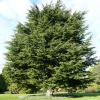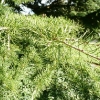Features
This evergreen conifer has dark green to blue green needles which grow up to 3cm long. When young they appear as individual needles in whorls around the stems, then grow in clusters on short stalks on more mature parts of the tree. The branches are tiered and slightly upright when young, forming a conical shape, but become more horizontal with age and, as a result, the tree becomes more rounded and spreading. Cedrus libani is a monoecious plant so it has separate male and female cones. Barrel-shaped, female cones (in which the seeds form) are visible, standing upright on branches, throughout the year. They grow to 12cm tall and are green when young, brown with a feint purple hue when ripe. The male cones (which contain the pollen) are smaller, more open and pale yellow in colour.
What to use it for
This is a very big tree which makes a wonderful focal point in a large garden, particularly if positioned on a lawn. It can also make a good subject for the art of Bonsai.
How to look after it
Ensure that the plant you have purchased isn’t pot bound as this is likely to result in a weak root system. Conifers shouldn’t be staked upon planting as they need the movement of the wind to strengthen the wind and root system. This plant doesn’t like to be transplanted, so ensure you pick the right spot to plant it in – it shouldn’t be moved once it is established.
As the tree ages you may find that some lower branches need to be propped up. Use a sturdy wooden crutch (if possible made out of a forked branch for a more natural look) to support the weight of the branch without forcing upwards.
How to prune it
Pruning should be kept to a minimum, particularly once the tree is mature. Initial training should be carried out, if necessary, to remove any stems competing with the central leader, or to replace a broken central leader with an alternative stem (tie it to a cane which is tied against the lower trunk, in order to keep it upright). If the central leader droops over at the tip don’t remove it; this is natural and it will straighten in time.
You may also wish to clear the trunk so it is visible at the bottom of the tree. This can be done once the tree reaches around 3m height and is growing strongly. Initially remove branches up to 1m height. Gradually extend this to clear up to 2m over the next few years. Continue to gradually increase the cleared amount over the next few years until the required amount of trunk is cleared (keeping in mind the ultimate height of the tree); we suggest you clear up to 5m.
Once the tree is mature pruning should only be carried out to remove dead, diseased or damaged branches. Cedrus libani should not be hard pruned.
All pruning should be carried out from autumn to midwinter as the plant may be weakened by excessive sap bleeding if pruned in the spring or summer.
How to propagate it
Collect seeds from mature cones (which are 3 years old) and break off their wings. Cold stratify them, keeping them moist, for 8 weeks then sow in pots at 15°C.
Common problems
May be affected by aphids and honey fungus.
Other useful information
Cedrus libani has been given the Award of Garden Merit by the RHS.
Cedar wood is used to repel insects (for example when hung in wardrobes) and in the past was used extensively for buildings and ships. The tree’s resin is used as an oil in perfumery and aromatherapy (it was also used for embalming by the ancient Egyptians).
The cedar is the most frequently mentioned tree in the Bible and is said to have been used in the building of King Solomon’s Palace and the Temple of Jerusalem. The Lebanese flag bears an image of a Lebanon cedar tree.






